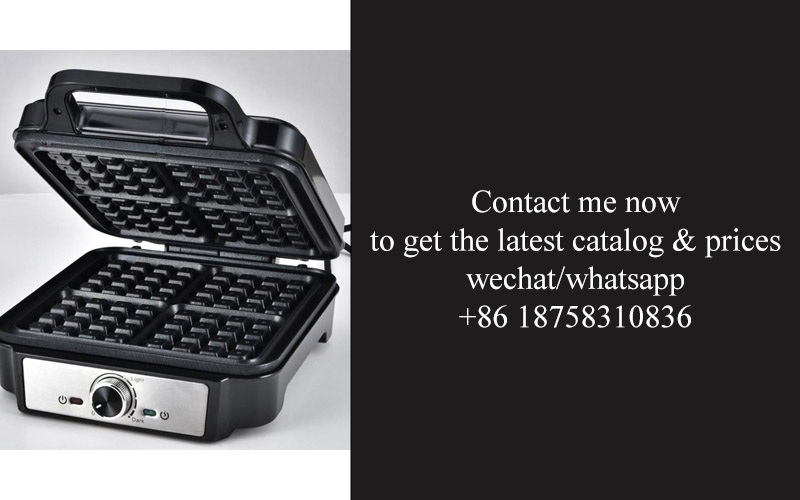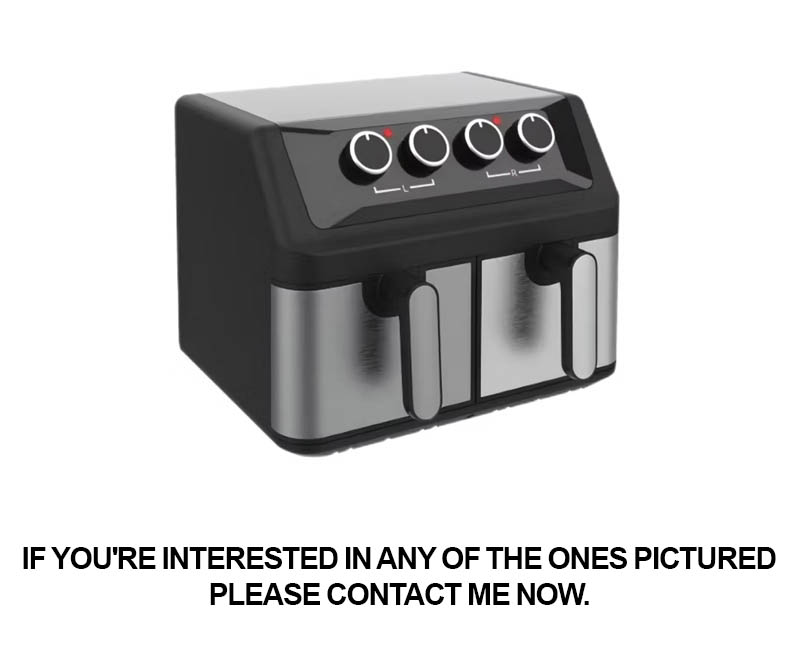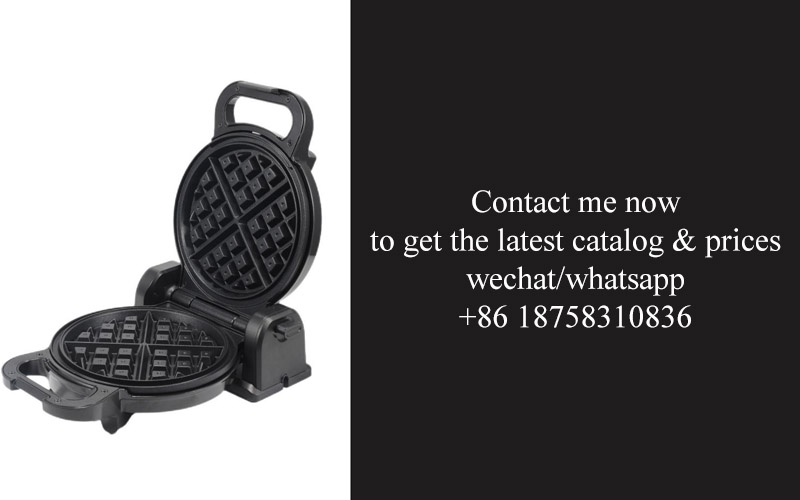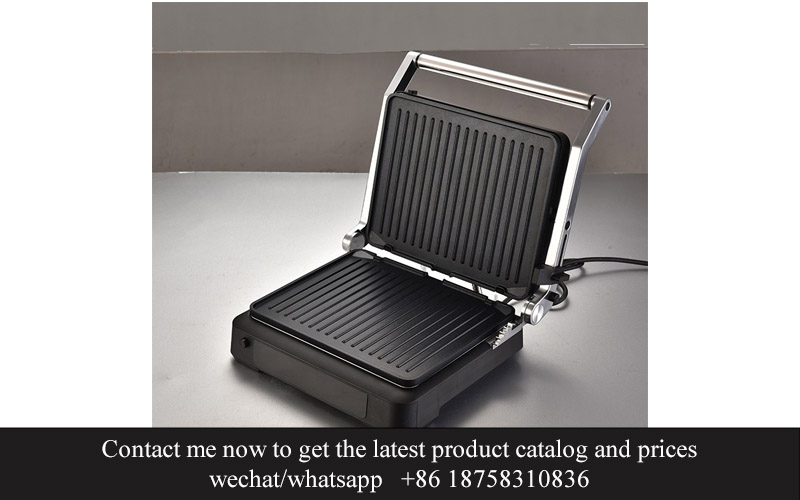Address
304 North Cardinal
St. Dorchester Center, MA 02124
Work Hours
Monday to Friday: 7AM - 7PM
Weekend: 10AM - 5PM
Address
304 North Cardinal
St. Dorchester Center, MA 02124
Work Hours
Monday to Friday: 7AM - 7PM
Weekend: 10AM - 5PM

Navigating the world of air fryer manufacturers can be a daunting task, especially when it comes to ensuring that you partner with a reliable supplier. With countless options out there, it’s crucial to delve into the nuances of their operations and offerings. In this section, we’ll delve into the intricacies of how to effectively negotiate and seal the deal with a potential air fryer factory, ensuring that you get the best possible outcome for your business. From understanding the finer points of pricing and payment terms to ensuring seamless logistics and delivery, this guide will help you navigate the final stages of securing a trustworthy partnership.
To embark on a successful venture into the air fryer market, it’s paramount to have a crystal-clear understanding of your needs and specifications. This foundational step ensures that the air fryer factory you choose aligns perfectly with your product vision. Let’s delve into the intricacies of this critical phase.
Firstly, you need to meticulously define the technical specifications of the air fryer you aim to produce. This includes the size of the fry basket, the capacity, and the power output. Consider whether you want a countertop model or a countertop oven that also serves as an air fryer. These details will shape the overall design and functionality of your product.
Secondly, think about the features you want to incorporate. Are you looking for an air fryer that is easy to clean, perhaps with non-stick coatings? Would you like to include features like a timer, temperature control, or an LCD display? These features will not only enhance the user experience but also differentiate your product in a competitive market.
Additionally, it’s essential to consider the safety aspects. Ensure that the air fryer meets all necessary safety standards, including those for overheating, electrical safety, and user-friendliness. The certifications, such as ETL, CE, or UL, should be at the forefront of your checklist.
Moreover, you’ll need to decide on the material used for the exterior and interior components of the air fryer. Common materials include plastic, stainless steel, and aluminum. Each has its own advantages and disadvantages in terms of durability, cost, and aesthetic appeal.
The dimensions of the air fryer are also crucial. You’ll need to ensure that it fits comfortably in your target market’s kitchen cabinets and that it is easy to store when not in use. This might involve creating a prototype or a mock-up to visualize the product in various kitchen settings.
Next, consider the branding and design elements. The air fryer’s appearance should be appealing to your target demographic. This could involve sleek lines, bold colors, or even a minimalist design. The design should not only be visually appealing but also functional, ensuring that the product is a joy to use.
Another aspect to ponder is the intended market segment. Are you targeting budget-conscious consumers or looking for premium appliances? The price point and perceived value of your product will greatly influence its market positioning and the choice of materials and features you opt for.
Additionally, you may want to include eco-friendly aspects in your air fryer. This could mean using recyclable materials, ensuring energy efficiency, or even offering a recycling program for the product at the end of its lifecycle.
Furthermore, consider the regulatory landscape. Different countries have varying rules and regulations regarding electrical appliances, and it’s crucial to understand these to ensure compliance. This includes voltage requirements, plug types, and any additional certifications that might be needed for specific markets.
Lastly, don’t underestimate the importance of after-sales service and warranty. Customers are more likely to trust a product that comes with robust support and a comprehensive warranty. This also extends to customer service, as prompt and effective responses to inquiries and issues can greatly enhance brand loyalty.
By taking the time to fully understand your needs and specifications, you set the stage for a successful partnership with an air fryer factory. This detailed planning not only helps you communicate your vision effectively but also ensures that the end product meets the expectations of your customers, making it a market hit.

When embarking on the quest for a reliable air fryer factory, the first step is to delve into the research phase. This is where you start to narrow down your options and ensure that you’re aligning with suppliers who can meet your specific needs. Here’s how you can conduct thorough research:
Start with Online Searches: Utilize search engines to find potential suppliers. Type in keywords such as “air fryer manufacturers,” “electrical appliance producers,” and “Chinese kitchen appliance suppliers.” This initial search will yield a long list of companies, both large and small.
Explore B2B Marketplaces: Platforms like Alibaba, Global Sources, and Made-in-China offer a vast array of suppliers. These marketplaces are a treasure trove of information, allowing you to filter suppliers based on their product range, location, and customer ratings.
Consult Industry Directories: Industry-specific directories can be a goldmine for finding reputable suppliers. These directories often include detailed profiles, contact information, and sometimes reviews from other buyers.
Join Trade Forums and Communities: Participating in online forums and communities dedicated to the kitchen appliance industry can provide insights into the reputation of certain suppliers. Members often share experiences and recommendations, which can be invaluable.
Attend Trade Shows and Expos: Trade events are a great way to meet suppliers face-to-face. They allow you to evaluate their products, ask questions, and establish a personal connection. Note that these events may require travel, so plan accordingly.
Check Supplier Reviews and Ratings: Look for reviews on B2B platforms, social media, and industry-specific websites. Pay attention to both the positive and negative feedback to get a well-rounded view of the supplier’s reliability.
Contact Industry Associations: Many industries have associations that regulate and accredit suppliers. Contacting these organizations can help you verify the legitimacy of a supplier and ensure they adhere to industry standards.
Analyze Supplier Websites: A well-designed and informative website can be a good indicator of a supplier’s professionalism. Look for clear product listings, detailed descriptions, certifications, and contact information.
Utilize Social Media: Social media platforms like LinkedIn, Facebook, and Instagram can be used to find suppliers. Many manufacturers use these platforms to showcase their products and services, and you can also check their engagement with potential customers.
Ask for Recommendations: Reach out to colleagues, friends, or industry contacts for recommendations. Personal referrals can be incredibly valuable, as they come with a level of trust that online research alone might not provide.
Consider Geographic Location: The location of the supplier can impact the cost, lead time, and logistics of your business. Proximity to your market or manufacturing facility might be a deciding factor.
Look for Sustainability and Ethical Practices: Some businesses prioritize sustainability and ethical practices. If this is important to you, research suppliers who align with these values.
Understand the Supply Chain: Investigate how the supplier sources its components and materials. A transparent supply chain can be a sign of a reliable and responsible manufacturer.
Prepare a Shortlist: After conducting your research, compile a shortlist of suppliers who seem to meet your criteria. This will help you focus your efforts on the most promising candidates.
Stay Updated: The kitchen appliance industry is dynamic, with new technologies and trends emerging regularly. Keep up-to-date with the latest industry news to ensure your research remains relevant.
By taking these steps, you’ll be well on your way to finding a reliable air fryer factory that not only meets your product specifications but also aligns with your business goals and values.

Navigating through the vast sea of suppliers can be daunting, but a thorough evaluation of their profiles is crucial to ensure you’re partnering with the right entity. Here’s how to delve into the details:
Company Background: Dive into the company’s history to understand its longevity and stability. Look for information on when the company was founded, its growth trajectory, and any significant milestones. A well-established company often indicates a strong foundation and a commitment to quality.
Industry Experience: Investigate how long the supplier has been operating in the air fryer industry. Experience can be a key indicator of their understanding of market trends, customer needs, and the technical nuances of air fryer manufacturing.
Product Portfolio: Examine the range of products the supplier offers. A diverse portfolio suggests they have the capability to cater to various market segments and can adapt to new product trends. Pay attention to the quality and innovation of their existing air fryer models.
Customization Capabilities: Not all businesses require a one-size-fits-all solution. Look for suppliers who offer customization services. This could mean the ability to modify existing products or develop entirely new ones to meet your specific requirements.
Certifications and Standards: Check for certifications such as ISO, CE, or UL, which indicate that the supplier adheres to international quality and safety standards. These certifications are crucial, especially if you’re targeting global markets.
Customer Base: Look into the supplier’s client list. A robust client base, including well-known brands, can be a testament to their reliability and the quality of their products. It also gives you an idea of the supplier’s ability to meet the demands of different types of customers.
Financial Stability: While it’s not always possible to access detailed financial statements, look for any available information about the supplier’s financial health. A financially stable supplier is less likely to suddenly disappear or fail to meet delivery deadlines.
Technology and Innovation: Modern suppliers invest in technology to improve their manufacturing processes and product quality. Look for any mention of R&D initiatives, technological upgrades, or patents that the supplier may hold.
Quality Control Measures: Quality is paramount in the air fryer industry. A reputable supplier will have robust quality control measures in place. They might use advanced testing equipment, employ strict quality assurance protocols, or have a dedicated quality control team.
Production Capacity: Consider the supplier’s production capacity to ensure they can meet your order volume. A supplier with excess capacity might be able to handle rush orders or accommodate larger orders without compromising on quality.
Supply Chain: A well-managed supply chain is essential for timely delivery and cost efficiency. Look into how the supplier sources materials, manages inventory, and handles logistics. A supplier with a reliable and efficient supply chain is less likely to face production delays.
Communication and Support: Effective communication is key to a successful business relationship. Evaluate the supplier’s communication channels, responsiveness, and willingness to support you throughout the partnership.
References and Testimonials: Seek out references from the supplier’s past clients. Real-world experiences can provide valuable insights into the supplier’s performance and the quality of their products and services.
Warranty and After-Sales Service: A supplier that stands behind its products with a solid warranty and after-sales service is likely to be more invested in the quality of its offerings. This can be a significant factor in your decision-making process.
Ethical Practices: Finally, consider the supplier’s ethical practices, including labor conditions, environmental impact, and corporate social responsibility initiatives. Choosing a supplier that aligns with your values can enhance your brand’s reputation.
By meticulously evaluating these aspects of a supplier’s profile, you can make a more informed decision and establish a partnership that is built on trust, quality, and mutual success.

Understanding the importance of quality assurance and certifications is paramount when selecting an air fryer factory. Here’s a closer look at what to consider:
Quality Control Processes in PlaceLook for suppliers who have a robust quality control system. This could include detailed checks at various stages of production, from raw materials to the final product. Ensure they have clear protocols for inspecting components, testing functionality, and verifying safety standards.
Certifications for ComplianceSeek suppliers who hold certifications that are recognized globally. Common certifications in the kitchen appliances industry include ISO 9001 for quality management, ISO 14001 for environmental management, and CE marking for conformity with EU safety, health, and environmental standards.
Audits and InspectionsAsk about the frequency and nature of audits. A supplier who undergoes regular third-party audits is likely to maintain high standards. Inquire about the types of inspections conducted, whether they are random or for specific batches, and how issues are addressed.
Testing ProceduresQuality assurance often involves rigorous testing. Find out about the specific tests the factory conducts, such as drop tests, heat resistance tests, and durability tests. Understanding these procedures gives you insight into how thoroughly the product is vetted.
Material StandardsThe quality of the materials used can greatly impact the longevity and performance of the air fryer. Ensure that the supplier adheres to strict material standards, using only top-grade components and non-toxic materials that meet health and safety regulations.
Supplier’s Track RecordLook into the supplier’s history with certifications. A supplier with a long-standing commitment to quality is more likely to maintain high standards. Check if they have faced any certification revocations or had their quality compromised in the past.
Customer Feedback on QualityCustomer reviews can be a goldmine of information about a supplier’s quality control. Look for patterns in customer feedback regarding product durability, reliability, and customer service. This can provide a real-world perspective on the supplier’s commitment to quality.
Training and Employee InvolvementThe level of training employees receive can indicate how seriously the supplier takes quality. A factory that invests in training its staff is more likely to have a culture of quality where every employee is responsible for maintaining high standards.
Certification Bodies UsedSome certification bodies are more reputable than others. Research the certification bodies the supplier works with to ensure they are known for their strict adherence to standards. This can also give you insight into the supplier’s willingness to undergo rigorous assessments.
Continuous ImprovementA supplier committed to continuous improvement is likely to be more proactive in addressing quality issues. Ask about their process for identifying areas for improvement and how they implement changes.
Documentation and TraceabilityEnsure that the supplier maintains thorough documentation of their quality processes. This documentation should be easily accessible and allow for traceability, so you can verify the quality of specific batches of products.
Industry Awards and AccoladesCheck if the supplier has received any industry awards or accolades for quality. These recognitions can be a strong indicator of their commitment to producing high-quality products.
Collaboration and OpennessA supplier who is open to collaboration and feedback is more likely to be responsive to quality concerns. Engage in discussions about their quality assurance processes and express any specific concerns you may have.
Long-Term Relationships with SuppliersLook for suppliers who have long-standing relationships with their raw material suppliers. This suggests a commitment to quality at the source, as reliable raw materials are essential for high-quality finished products.
By thoroughly evaluating the quality assurance and certifications of potential suppliers, you can make an informed decision that ensures the air fryers you source meet the highest standards of quality and safety.

Navigating through the myriad of suppliers can be daunting, but delving into the quality assurance and certifications of potential partners is a critical step in ensuring that the air fryer factory you choose meets your standards. Here’s how to thoroughly check these aspects:
Inspecting Quality Control Measures– Look for detailed information on the supplier’s quality control processes. This could include regular audits, in-house testing facilities, and adherence to specific quality standards.- Ask about the frequency and rigor of inspections throughout the production process. A supplier that conducts thorough checks at various stages is more likely to deliver a high-quality product.- Inquire about any certifications they hold that pertain to quality control, such as ISO 9001, which is an internationally recognized standard for quality management.
Understanding Certifications and Standards– Research the certifications that are relevant to your industry and product. For air fryers, certifications like CE, which stands for Conformité Européenne, are crucial as they ensure compliance with European safety, health, and environmental protection standards.- Ask for certifications related to specific aspects of the air fryer’s production, such as electrical safety (UL, TUV), material safety (RoHS), and energy efficiency (Energy Star).- Don’t hesitate to ask for a copy of the certifications or to see the actual certificates to verify their authenticity.
Analyzing Testing Protocols– A reliable supplier will have a clear set of testing protocols for their products. These might include drop tests, temperature consistency checks, and durability tests.- Request details about the testing equipment and methodologies used. Advanced testing equipment and rigorous protocols are indicative of a supplier’s commitment to quality.- If possible, ask for a list of the tests that the supplier conducts on their air fryers and the results of these tests.
Reviewing Product History– Look into the supplier’s history with similar products. A track record of producing high-quality air fryers over time can be a strong indicator of their commitment to quality.- Check customer reviews and testimonials to gauge the supplier’s reputation for delivering products that meet or exceed expectations.- Don’t shy away from asking for case studies or examples of past projects where the supplier has successfully delivered products that required stringent quality control.
Visiting the Factory– If feasible, arrange a visit to the supplier’s factory. Seeing the manufacturing process firsthand can provide invaluable insights into their quality assurance practices.- During the visit, pay attention to the cleanliness and organization of the factory. A well-maintained facility is often a sign of a supplier that takes quality seriously.- Observe how employees interact with the products and whether they appear knowledgeable about the quality control procedures in place.
Engaging in Dialogue– Engage in a dialogue with the supplier’s quality assurance team. They should be able to articulate their processes and procedures clearly and confidently.- Ask about any challenges they’ve faced in maintaining quality and how they’ve addressed them. This can reveal how adaptable and proactive the supplier is.- Discuss any changes in the industry or regulations that have impacted their quality assurance practices and how they’ve adjusted to these changes.
Verifying Third-Party Audits– If the supplier claims to have a robust quality assurance system, ask about any third-party audits they’ve undergone. Independent audits can lend credibility to their claims.- Request access to audit reports or summaries that detail the findings of these audits. This can provide a comprehensive view of the supplier’s quality control efforts.
Assessing Compliance with Regulations– Ensure that the supplier’s products comply with all relevant local and international regulations. This includes safety standards, environmental regulations, and import/export requirements.- Ask about the supplier’s process for staying up-to-date with changes in regulations and how they ensure compliance with these changes.
Final Thoughts– Remember that quality assurance and certifications are not just about meeting standards; they’re about building trust with your customers. A supplier that takes these aspects seriously is more likely to deliver a product that meets your expectations and those of your customers.- Take the time to thoroughly evaluate the quality assurance and certifications of potential suppliers. It’s a crucial step in the procurement process that can save you time, money, and headaches in the long run.

Navigating through the bustling halls of a factory can be both enlightening and daunting. The layout, the machines, the workflow—it all speaks volumes about a supplier’s commitment to quality and efficiency. Here’s a closer look at what to observe when reviewing manufacturing facilities:
The Layout and Organization– The first thing to notice is the overall layout. Is the facility well-organized, or does it feel chaotic? A clean, structured layout often indicates a supplier that values efficiency and order.
State-of-the-Art Equipment– Look for modern, high-tech machinery. Outdated equipment can lead to inefficiencies and, potentially, lower-quality products. State-of-the-art machines not only ensure precision but also suggest a supplier’s investment in staying current with industry advancements.
Workforce Training and Expertise– Observe the workers. Are they wearing protective gear, and do they seem knowledgeable about the processes they’re performing? A well-trained workforce is crucial for consistent quality and safety.
Quality Control Measures– Quality control is paramount. Check if there are visible quality checks at various stages of the production process. This could be in the form of automated inspections or manual inspections by quality control personnel.
Cleanliness and Maintenance– The cleanliness of the facility is a reflection of the supplier’s attention to detail. A spotless environment reduces the risk of contamination and suggests a focus on hygiene and safety.
Inventory Management– Efficient inventory management is key to maintaining a smooth production line. Look for signs of organized storage, minimal waste, and a system that tracks inventory levels accurately.
Safety Standards– Safety should be a top priority. Check for safety protocols, such as emergency exits, fire suppression systems, and safety training for employees. A supplier that prioritizes safety is less likely to compromise on product quality.
Environmental Considerations– In today’s world, environmental responsibility is increasingly important. Look for any initiatives the supplier has in place to reduce their environmental footprint, such as energy-efficient practices or recycling programs.
Capacity and Scalability– Consider the supplier’s capacity to handle your order size and future growth. A factory with the ability to scale up production can be a reliable partner as your business expands.
Technology Integration– Modern factories are integrating advanced technologies like IoT (Internet of Things) and AI (Artificial Intelligence) to enhance productivity and reduce errors. Look for these technologies in use within the facility.
Communication and Collaboration– Observe how the team communicates and collaborates. A factory that encourages open dialogue and cross-departmental collaboration is likely to be more adaptable and responsive to customer needs.
Customer-Focused Approach– Pay attention to how the supplier addresses customer concerns. A factory that has customer service representatives readily available and a clear process for handling issues is a good sign.
Certifications and Compliance– Look for certifications that the supplier holds, such as ISO standards, which demonstrate their adherence to quality management systems. These certifications can provide peace of mind regarding the consistency and reliability of their products.
Long-Term Vision– Finally, consider the supplier’s long-term vision. A supplier with a clear strategy for growth and innovation is more likely to be a reliable partner over the long term.
By thoroughly reviewing these aspects of a manufacturing facility, you can gain a comprehensive understanding of the supplier’s capabilities and commitment to delivering high-quality products. Remember, a visit to the factory is not just about assessing the current production run; it’s about envisioning a future partnership that will stand the test of time.

Understanding the pricing structure and payment terms when dealing with an air fryer factory is crucial for ensuring a fair and profitable transaction. Here’s a deeper look into what you should consider:
Understanding Pricing Structure
Negotiating Pricing
Payment Terms to Consider
Evaluating Payment Methods
Long-Term Financial Planning
Reviewing Contractual Agreements
By thoroughly analyzing pricing and payment terms, you can make informed decisions that protect your investment and ensure a smooth business relationship with the air fryer factory.

Navigating the logistics and delivery aspect of sourcing air fryers from a factory is a critical step that can greatly impact your business. Here’s a closer look at what you should consider:
The Importance of Timely DeliveryTimely delivery is paramount, especially in the fast-paced world of consumer electronics. Punctuality ensures that your inventory remains stocked, reducing the risk of stockouts and customer dissatisfaction. A reliable supplier should be able to provide you with a clear timeline for production and shipping.
Understanding Shipping CostsShipping costs can vary widely depending on the volume, destination, and the supplier’s preferred shipping methods. It’s essential to get a detailed breakdown of these costs to ensure they align with your budget. Be wary of hidden fees and unexpected charges that might arise during the shipping process.
Modes of TransportationThe choice of transportation can affect both the cost and speed of delivery. Air freight is typically faster but more expensive, while sea freight is cheaper but takes longer. Evaluate which option suits your business model and delivery time requirements. Some suppliers may offer a combination of both, providing flexibility based on your needs.
Customs and Import RegulationsWhen dealing with international suppliers, it’s crucial to understand the customs and import regulations of the destination country. This includes tariffs, duties, and any documentation required for importing goods. A supplier well-versed in these regulations can help streamline the process and avoid costly delays.
Local PartnershipsSuppliers who have established partnerships with local freight forwarders and customs brokers can make the import process smoother. These partnerships can help navigate complex procedures and ensure that your products clear customs quickly and efficiently.
Lead Times and Inventory ManagementThe lead time from order placement to delivery should be clearly communicated by your supplier. This includes the time for manufacturing, quality checks, and transportation. Understanding the lead time is vital for inventory management, as it affects how much stock you need to order and when.
Tracking and TransparencyA good supplier will offer tracking services so you can monitor the progress of your shipment in real-time. Transparency about the status of your order and any potential delays is key to maintaining a good relationship and ensuring customer satisfaction.
Contingency PlanningUnexpected issues can arise, such as production delays or shipping disruptions. A reliable supplier will have contingency plans in place to address these issues. Discuss how the supplier handles unforeseen circumstances and how this will impact your business.
Insurance and Risk ManagementEnsure that the supplier offers insurance for the goods during transit. This protects you against loss or damage to the products en route to your warehouse. It’s also important to discuss how risks are managed and what steps are taken to prevent such incidents.
Feedback and ImprovementAfter your first shipment, seek feedback from your supplier on the delivery process. This can help identify areas for improvement and ensure that future deliveries are even more efficient. A supplier who values your business will be open to discussing and implementing changes.
In conclusion, logistics and delivery are more than just getting products from point A to point B. They are a reflection of the supplier’s commitment to customer satisfaction and the efficiency of their operations. By carefully considering these factors, you can ensure a smooth and cost-effective supply chain for your air fryer business.

Navigating through customer reviews and testimonials can be a treasure trove of insights when seeking a reliable air fryer factory. These sources are not just words on a page; they are the voice of the customer, echoing their experiences and satisfaction levels. Here’s how to sift through them effectively:
Understanding the LandscapeCustomer reviews and testimonials come in various forms, from detailed feedback on product features to concise ratings and comments. They can be found on e-commerce platforms, social media, and the suppliers’ own websites. It’s crucial to understand that while reviews are subjective, they often reflect common experiences and concerns.
Identifying Reliable SourcesNot all reviews are created equal. Look for platforms that are known for their authenticity and high standards, such as Amazon, Yelp, or specialized industry forums. These sites often have robust systems to verify reviews, ensuring they are genuine and not influenced by fake accounts.
Assessing the Consistency of FeedbackOne review might highlight a minor flaw, but if that same issue is mentioned repeatedly across multiple sources, it’s a red flag. Pay attention to patterns in the feedback. Are there common praises or complaints? This consistency can indicate a broader issue that the factory might need to address.
Looking for Specific DetailsWhen reading reviews, look for specifics. A customer might say the air fryer is “great,” but what does that really mean? Are they talking about the cooking performance, ease of use, or the durability of the appliance? Detailed reviews often mention these aspects, giving you a clearer picture of the product’s strengths and weaknesses.
Analyzing the Range of FeedbackIt’s not just about the negative reviews; positive feedback is equally important. A product that has a mix of reviews, with both glowing praise and constructive criticism, can be a sign of a well-rounded and reliable product. It shows that the factory is responsive to customer needs and improvements.
Checking for Testimonials from InfluencersInfluencers and industry experts often provide detailed testimonials that can be more in-depth than average customer reviews. These can be particularly valuable as they often come from individuals with a deeper understanding of the product category.
Understanding the ContextSometimes, reviews might be skewed by external factors. For example, a customer might complain about the delivery time, not the product itself. It’s important to consider the context of each review to avoid drawing conclusions based on irrelevant information.
Cross-Referencing with Other InformationDon’t rely solely on reviews. Cross-reference the information with other sources, such as the supplier’s website, industry reports, and news articles. This will help you get a more comprehensive view of the factory’s reputation and the product’s performance.
Identifying Common ThemesCommon themes in reviews can reveal a lot about the factory’s quality control, customer service, and product development process. Look for themes like “excellent customer support,” “quick response to issues,” or “consistent product quality.”
Evaluating the Factory’s ResponseA factory’s willingness and ability to address customer concerns is a significant indicator of its reliability. If a factory actively engages with customers to resolve issues, it shows a commitment to customer satisfaction.
Considering the TimelineReviews that are older might not reflect the current state of the product or the factory’s operations. However, if you find that older reviews are consistently positive, it can be a good sign of long-term reliability.
By thoroughly examining customer reviews and testimonials, you can gain valuable insights into the quality and reliability of the air fryer factory and its products. It’s a process that requires patience and attention to detail, but it can be a powerful tool in making an informed decision.

Navigating the negotiation process can be a delicate balance between securing a favorable deal and maintaining a positive relationship with your supplier. Here’s how to approach it:
Understanding the Supplier’s PositionBefore diving into negotiations, it’s crucial to understand the supplier’s perspective. Consider their business model, target market, and what they might be looking for in a partnership. This knowledge can help you anticipate their stance and prepare your own negotiation strategy.
Setting Clear ObjectivesDefine what you want to achieve in the negotiation. Are you looking for the best price, improved terms, or additional services? Having clear objectives will keep you focused and help you make informed decisions during the negotiation.
Researching Market RatesBefore you start negotiating, research the market rates for similar products or services. This will give you a baseline to compare against the supplier’s initial offer and help you determine if their pricing is competitive.
Open CommunicationMaintain open and honest communication throughout the negotiation process. Be clear about your expectations and listen actively to the supplier’s points. Effective communication can prevent misunderstandings and build trust.
Flexibility and CompromiseBe prepared to be flexible. While you have your objectives, there may be areas where you can compromise to reach a mutually beneficial agreement. Understanding where you can bend and where you stand firm is key to successful negotiations.
Understanding Contractual ClausesGo through the contract with a fine-tooth comb. Pay attention to key areas such as delivery times, payment terms, and any penalties or fees. If there are clauses that seem unfavorable, discuss them openly and seek to modify them.
Negotiating Payment TermsPayment terms can significantly impact your cash flow. Negotiate for favorable payment terms that align with your business needs. This might include discounts for early payment, extended payment schedules, or even payment in installments.
Reviewing Legal and Compliance IssuesEnsure that the contract complies with all relevant laws and regulations. Discuss any legal concerns with your legal advisor and address them with the supplier. It’s essential to protect both parties from potential legal issues down the line.
Building Long-Term RelationshipsKeep in mind that negotiations are not just about the immediate deal but also about the potential for a long-term partnership. Be respectful and professional, and look for ways to create a win-win situation that can lead to a sustainable business relationship.
Using Mediation When NecessaryIf negotiations become deadlocked, consider using a mediator. A neutral third party can help facilitate discussions and find common ground that both parties can agree on.
Closing the DealOnce you’ve reached an agreement, ensure that all terms are clearly documented in the contract. Review the contract thoroughly to confirm that all negotiated points have been included.
Post-Negotiation Follow-UpAfter the deal is finalized, send a follow-up email or letter to the supplier to express your gratitude for their cooperation. Maintaining a positive relationship can be beneficial for future transactions and collaborations.
Remember, negotiation is an art and a science. It requires patience, strategy, and a willingness to adapt. By approaching the process with these considerations in mind, you can increase your chances of closing a deal that benefits both you and your supplier.